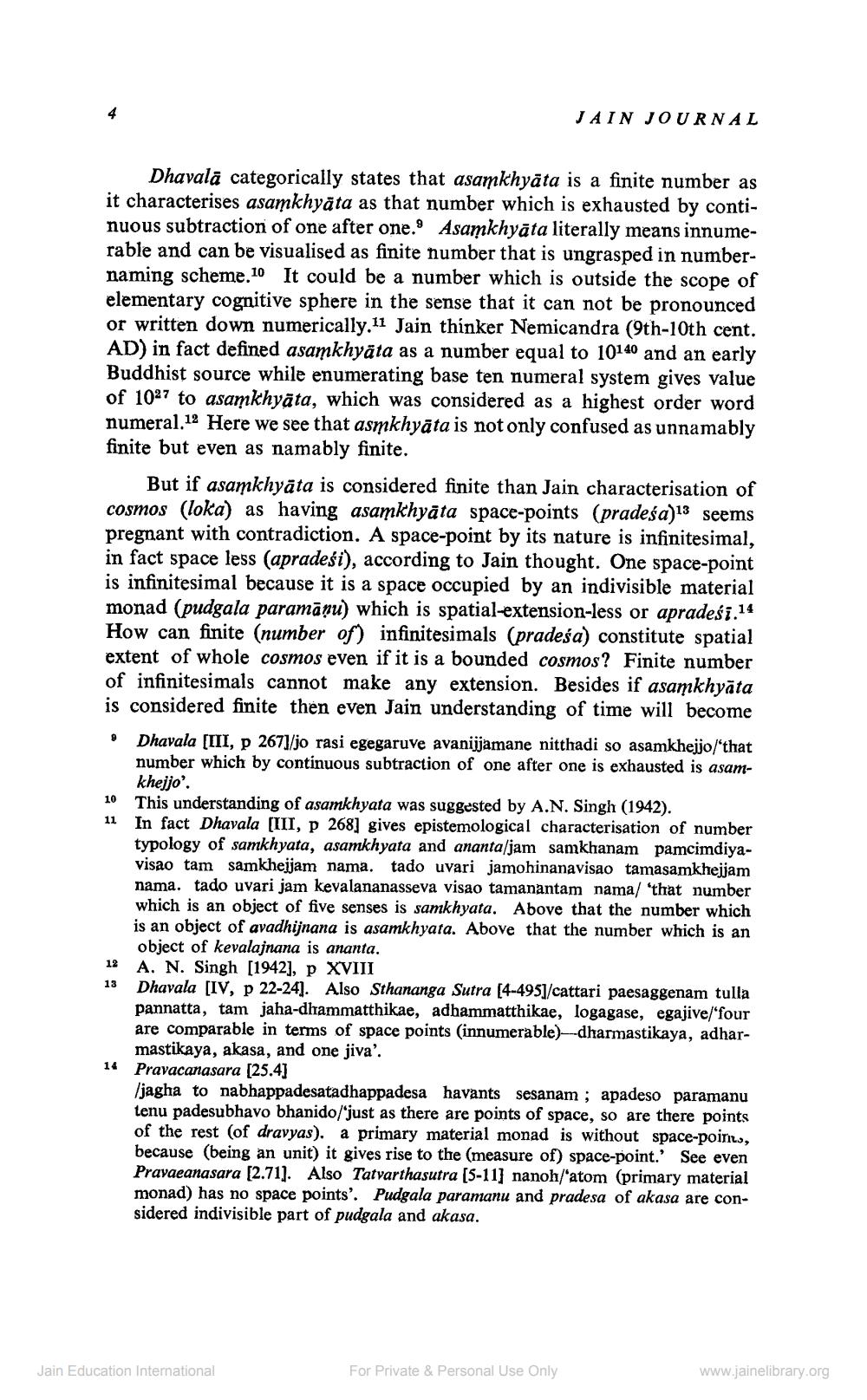Book Title: Jain Journal 1990 07 Author(s): Jain Bhawan Publication Publisher: Jain Bhawan Publication View full book textPage 9
________________ Dhavala categorically states that asamkhyāta is a finite number as it characterises asamkhyāta as that number which is exhausted by continuous subtraction of one after one. Asamkhyāta literally means innumerable and can be visualised as finite number that is ungrasped in numbernaming scheme.10 It could be a number which is outside the scope of elementary cognitive sphere in the sense that it can not be pronounced or written down numerically.11 Jain thinker Nemicandra (9th-10th cent. AD) in fact defined asamkhyāta as a number equal to 10140 and an early Buddhist source while enumerating base ten numeral system gives value of 1027 to asamkhyāta, which was considered as a highest order word numeral.12 Here we see that asmkhyāta is not only confused as unnamably finite but even as namably finite. But if asamkhyāta is considered finite than Jain characterisation of cosmos (loka) as having asamkhyāta space-points (pradeśa)13 seems pregnant with contradiction. A space-point by its nature is infinitesimal, in fact space less (apradesi), according to Jain thought. One space-point is infinitesimal because it is a space occupied by an indivisible material monad (pudgala paramāņu) which is spatial-extension-less or apradesi.14 How can finite (number of) infinitesimals (pradeśa) constitute spatial extent of whole cosmos even if it is a bounded cosmos? Finite number of infinitesimals cannot make any extension. Besides if asamkhyāta is considered finite then even Jain understanding of time will become 9 Dhavala [III, p 2671/jo rasi egegaruve avanijjamane nitthadi so asamkhejjo/'that number which by continuous subtraction of one after one is exhausted is asamkhejjo'. JAIN JOURNAL 10 This understanding of asamkhyata was suggested by A.N. Singh (1942). 11 In fact Dhavala [III, p 268] gives epistemological characterisation of number typology of samkhyata, asamkhyata and ananta/jam samkhanam pamcimdiyavisao tam samkhejjam nama. tado uvari jamohinanavisao tamasamkhejjam nama. tado uvari jam kevalananasseva visao tamanantam nama/ 'that number which is an object of five senses is samkhyata. Above that the number which is an object of avadhijnana is asamkhyata. Above that the number which is an object of kevalajnana is ananta. 12 13 14 A. N. Singh [1942], p XVIII Dhavala [IV, p 22-24]. Also Sthananga Sutra [4-495]/cattari paesaggenam tulla pannatta, tam jaha-dhammatthikae, adhammatthikae, logagase, egajive/"four are comparable in terms of space points (innumerable)-dharmastikaya, adharmastikaya, akasa, and one jiva'. Pravacanasara [25.4] /jagha to nabhappadesatadhappadesa havants sesanam; apadeso paramanu tenu padesubhavo bhanido/'just as there are points of space, so are there points of the rest (of dravyas). a primary material monad is without space-poins, because (being an unit) it gives rise to the (measure of) space-point.' See even Pravaeanasara [2.71]. Also Tatvarthasutra [5-11] nanoh/'atom (primary material monad) has no space points'. Pudgala paramanu and pradesa of akasa are considered indivisible part of pudgala and akasa. Jain Education International For Private & Personal Use Only www.jainelibrary.orgPage Navigation
1 ... 7 8 9 10 11 12 13 14 15 16 17 18 19 20 21 22 23 24 25 26 27 28 29 30 31 32 33 34 35 36 37 38 39 40 41 42 43 44 45
